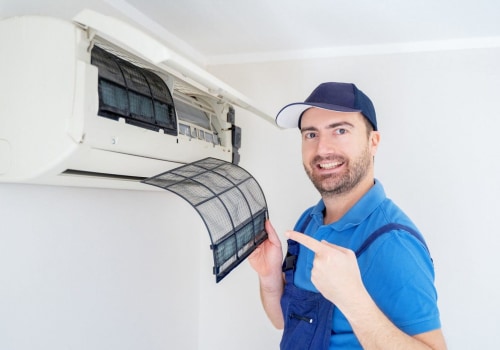20x25x5 Furnace HVAC Air Filters
What factors contribute to the optimal functioning of a furnace HVAC system? One crucial element is regularly replacing the air filter. This article explores the significance of 20x25x5 Furnace HVAC Air Filters. Additionally, it offers guidance on selecting the appropriate HVAC air filter for your furnace and highlights the benefits of using a high-quality filter. Furthermore, it provides step-by-step instructions for changing the 20x25x5 furnace air filter while identifying common installation mistakes to avoid. Lastly, it presents tips for extending the lifespan of your chosen filter.
The Importance of Regularly Replacing Your Furnace Air Filter
Regularly replacing the furnace air filter is crucial for maintaining the efficiency and effectiveness of the HVAC system. The importance of regular maintenance cannot be overstated, as a clean air filter ensures proper airflow and filtration within the system. A dirty or clogged filter can lead to a variety of issues that can negatively impact both the performance of the HVAC system and the indoor air quality.
One key sign indicating a dirty filter is reduced airflow. When a filter becomes clogged with dirt, dust, and other particles, it restricts the flow of air through the system. This reduction in airflow can result in decreased efficiency as the HVAC system has to work harder to maintain desired temperatures. Additionally, a dirty filter may cause an increase in energy consumption due to this added strain on the system.
Another sign of a dirty filter is poor indoor air quality. As particles accumulate on an uncleaned filter, they are no longer effectively trapped and removed from circulating air within your home or office space. This can lead to increased levels of airborne contaminants such as pollen, dust mites, pet dander, and mold spores circulating throughout your living environment.
To ensure optimal performance and energy efficiency while maintaining good indoor air quality, regular replacement of furnace air filters is essential. By adhering to manufacturer recommendations for frequency of replacement based on factors such as usage level and environmental conditions, one can prevent common problems associated with dirty filters like reduced airflow and compromised indoor air quality.
Understanding the 20x25x5 Filter Size
Consistently replacing filters with the dimensions of 20x25x5 is essential for maintaining optimal performance in heating, ventilation, and air conditioning systems. Understanding filter efficiency and the benefits of proper filtration can help users appreciate the importance of regularly replacing these filters.
Filter efficiency refers to a filter's ability to capture and remove particles from the air. It is typically measured using a metric called Minimum Efficiency Reporting Value (MERV). The MERV scale ranges from 1 to 16, with higher numbers indicating greater efficiency. Filters with a MERV rating of 11 or higher are considered highly efficient and can effectively capture small particles such as pollen, pet dander, dust mites, mold spores, and even some bacteria.
Proper filtration offers several benefits for HVAC systems and indoor air quality. Firstly, it helps prevent the buildup of dirt and debris on system components such as coils and fans, reducing energy consumption and extending equipment lifespan. Secondly, it improves indoor air quality by removing airborne contaminants that can cause allergies or respiratory issues. Thirdly, it promotes better airflow throughout the system, enhancing overall performance.
Regularly replacing filters ensures that they maintain their efficiency over time. Clogged or dirty filters restrict airflow and strain the HVAC system's motor, leading to reduced performance and potentially costly repairs. By adhering to a regular maintenance schedule and understanding filter efficiency principles along with the benefits of proper filtration can help users optimize their HVAC systems' functionality while ensuring clean indoor air quality.
How to Choose the Right HVAC Air Filter for Your Furnace
This discussion will focus on three key points in choosing the right HVAC air filter for your furnace: filter size and compatibility, MERV rating importance, and the choice between disposable and washable filters. First, it is crucial to ensure that the filter size matches the dimensions of your furnace to guarantee proper installation and optimal performance. Next, considering the MERV rating is important as it indicates the efficiency of the filter in capturing airborne particles and allergens. Lastly, deciding between disposable and washable filters depends on factors such as convenience, cost-effectiveness, and environmental impact.
Filter Size and Compatibility
One important factor to consider when selecting a furnace HVAC air filter is the size and compatibility of the filter. Proper sizing ensures optimal performance and efficiency of the filtration system. HVAC filters come in different sizes, with the most common being 1 inch, 2 inches, 4 inches, and 5 inches in thickness. It is essential to choose a filter that fits snugly into the designated filter slot without any gaps or spaces around it. In addition to size, compatibility is also crucial as not all filters are designed to work with every type of furnace. Different filter types such as fiberglass, pleated, washable, and electrostatic have varying levels of efficiency in capturing airborne particles and allergens. Therefore, understanding the specific requirements of your furnace system will help you select a suitable filter that effectively improves indoor air quality while maximizing energy efficiency.
MERV Rating Importance
The MERV rating of an HVAC filter is an important factor to consider when selecting a suitable filter for improving indoor air quality and maximizing energy efficiency. The MERV (Minimum Efficiency Reporting Value) rating is a numerical value that represents the performance of an air filter in trapping airborne particles. It indicates the filter's ability to remove particles of different sizes from the air, ranging from larger dust particles to smaller microscopic allergens. Higher MERV ratings indicate higher filtration efficiency and better removal of contaminants from the air. Different types of MERV ratings are available, typically ranging from 1 to 20, with higher numbers indicating better filtration capabilities. However, it should be noted that selecting a filter with too high of a MERV rating can restrict airflow in the HVAC system, potentially causing damage or reducing energy efficiency. Therefore, it is crucial to choose an air filter with an appropriate MERV rating based on specific needs and requirements.
Disposable Vs. Washable
Disposable and washable filters are two options for improving indoor air quality and energy efficiency in HVAC systems. Reusable options, such as washable filters, are gaining popularity due to their potential environmental impact. Washable filters can be cleaned and reused multiple times, reducing the amount of waste generated compared to disposable filters. This makes them a more sustainable choice in terms of resource consumption and landfill waste reduction. However, it is important to consider that washable filters require regular maintenance and proper cleaning techniques to ensure optimal performance. On the other hand, disposable filters offer convenience as they can be easily replaced without the need for cleaning or maintenance. While they contribute to more waste generation, some disposable filters now come with recyclable materials or even biodegradable options, which can help mitigate their environmental impact. Ultimately, the choice between disposable and washable filters should take into account both the desired level of air quality improvement and the individual's commitment to sustainability practices.
The Benefits of Using a High-Quality Furnace Air Filter
Using a high-quality furnace air filter can provide significant advantages. One such advantage is the ability to improve the overall air quality in a household or commercial building. A high-quality electrostatic furnace air filter, for instance, can effectively trap and remove airborne particles such as dust, pollen, pet dander, and mold spores from the circulating air. This is particularly important because poor indoor air quality can hurt the efficiency of HVAC systems.
When the air quality is compromised, HVAC systems may experience reduced efficiency due to clogged filters and increased strain on components. By using a high-quality furnace air filter, these problems can be minimized or even eliminated altogether. The electrostatic nature of these filters allows them to attract and capture particles with an electrical charge, preventing them from entering and accumulating within the system.
Moreover, by improving indoor air quality through the use of high-quality furnace filters, occupants can benefit from cleaner and healthier breathing environments. This is especially beneficial for individuals with respiratory conditions or allergies as it helps reduce their exposure to allergens and irritants present in the air.
Step-by-Step Guide to Changing Your 20x25x5 Furnace Air Filter
Filter maintenance is an essential aspect of ensuring the proper functioning of furnace HVAC air filters. Troubleshooting furnace filters involves inspecting and replacing them regularly to maintain indoor air quality. A step-by-step guide can be followed to change a 20x25x5 furnace air filter effectively.
First, it is important to turn off the furnace before attempting any maintenance work. Next, locate the filter compartment, which is typically found near the blower motor or in the return air duct. Carefully remove the old filter from its housing and dispose of it properly.
Inspecting the new filter before installation is crucial to ensure its compatibility with the system's specifications. Inserting the new filter into the housing should be done carefully, making sure it fits snugly without any gaps.
Once installed, turn on the furnace and monitor its operation for any unusual sounds or inefficiencies that may indicate a problem with the newly installed filter. Regularly checking and changing filters will help maintain a clean and efficient HVAC system while improving indoor air quality.
Common Mistakes to Avoid When Installing a New HVAC Air Filter
When installing a new HVAC air filter, it is important to avoid common mistakes in order to ensure proper functioning and optimal performance. One of the most common installation errors is neglecting to remove the old filter before inserting the new one. This can lead to reduced airflow and decreased efficiency of the system. Another mistake is using the wrong size or type of filter for the HVAC unit. It is crucial to select a filter that matches the dimensions specified by the manufacturer and meets the filtration needs of your specific system.
Proper filter placement is another critical aspect of correct installation. Filters should be installed with the arrow indicating airflow direction pointing towards the furnace or air conditioning unit. Installing them backwards can impede airflow, reduce efficiency, and potentially damage the system over time.
Additionally, failing to secure or seal the filter properly can result in air bypassing around it, allowing contaminants into your HVAC system and reducing its overall effectiveness. Make sure that all edges are properly aligned and sealed within their designated slot.
Tips for Extending the Lifespan of Your 20x25x5 Furnace Air Filter
To extend the lifespan of a furnace air filter with dimensions 20x25x5, it is important to implement certain measures that promote longevity and effectiveness. Regular cleaning of the filter is essential for maintaining its efficiency and improving indoor air quality. One tip for cleaning your 20x25x5 furnace air filter is to vacuum it regularly using a soft brush attachment. This will remove any loose debris and dust that may have accumulated on the surface of the filter. Another effective method is to rinse the filter with water, ensuring that it is completely dry before reinstalling it in the furnace. Additionally, consider using a protective cover or pre-filter to trap larger particles before they reach the main filter, which can help prolong its lifespan.
Improving indoor air quality with your furnace air filter involves more than just regular cleaning. It is also important to choose a high-quality filter that meets industry standards for efficiency and particle removal. Look for filters with a higher MERV (Minimum Efficiency Reporting Value) rating, as they are more effective at trapping smaller particles such as pollen, pet dander, and dust mites. Finally, ensure proper installation by following manufacturer instructions and replacing the filter according to recommended intervals.
Frequently Asked Questions
How Often Should I Replace My 20x25x5 Furnace Air Filter?
The frequency of replacing furnace air filters depends on various factors, including the quality of the filter and environmental conditions. Higher quality filters, such as HEPA filters, can improve furnace performance by trapping more particles and improving indoor air quality.
Can I Use a Different Filter Size for My Furnace?
Using a filter size that is different from the recommended specifications for a furnace may lead to compatibility issues. For example, if a smaller filter is used, it may not effectively capture particles and pollutants, reducing the overall efficiency of the HVAC system.
What Are the Different Types of Furnace Air Filters Available?
A variety of furnace air filters are available, each offering distinct benefits. These different types include fiberglass filters, pleated filters, electrostatic filters, and HEPA filters. Each type has specific advantages in terms of filtration efficiency and air quality improvement.
How Do I Know if I Have a High-Quality Furnace Air Filter?
To determine the efficiency of a furnace air filter, one must consider its filter efficiency and MERV rating. Filter efficiency refers to the ability to capture particles, while choosing the right MERV rating ensures a high-quality furnace air filter.
Are There Any Specific Maintenance Requirements for a 20x25x5 Furnace Air Filter?
Specific maintenance requirements for furnace air filters include regular replacement, typically every 3 months. Regular filter replacement offers benefits such as improved indoor air quality, increased efficiency of the HVAC system, and prevention of potential damage to the furnace.







